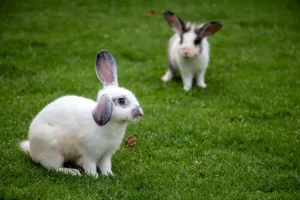Looking to provide your rabbits with the freshest and most nutritious food? Want to ensure a continuous supply of Timothy hay for their well-being? Look no further!
In this article, we’ll guide you through the process of growing Timothy hay for your furry friends. From choosing the perfect location to harvesting and storing, you’ll learn all the steps necessary to cultivate a thriving crop.
Get ready to become a master hay grower and satisfy your rabbits’ cravings!
In This Article
- 1 Key Takeaways
- 2 Choosing the Right Location for Your Timothy Hay
- 3 Preparing the Soil for Successful Timothy Hay Growth
- 4 Selecting and Planting Timothy Hay Seeds
- 5 Caring for Your Timothy Hay Crop
- 6 Harvesting and Storing Timothy Hay for Your Rabbits
- 7 Tips for Maintaining a Continuous Supply of Timothy Hay
- 8 Frequently Asked Questions
- 9 Conclusion
Key Takeaways
- Prioritize suitability of the soil: Choose a location with well-drained soil and a pH level between 6 and 7.
- Properly prepare the soil: Use compost and fertilizer to improve soil structure and add essential nutrients.
- Select and plant certified organic seeds: Choose plump, uniform seeds with a high germination rate and sow them evenly at a depth of ¼ inch.
- Monitor moisture levels and harvest and store hay properly: Regularly monitor moisture levels, dry hay until it reaches a moisture content of 12-18%, and store it in a well-ventilated, cool, and dry place to prevent mold growth.
Choosing the Right Location for Your Timothy Hay
You should prioritize the suitability of the soil when choosing the right location for your Timothy Hay. The soil plays a crucial role in the growth and quality of your hay.
When selecting a location for timothy hay cultivation, there are several factors to consider. Firstly, ensure that the soil is well-drained to prevent waterlogging, as excess moisture can lead to root rot and poor hay quality.
Additionally, timothy hay thrives in soil with a pH level between 6 and 7. Conduct a soil test to determine the pH level and make necessary amendments if needed.
Furthermore, the soil should be fertile, rich in organic matter, and have good nutrient availability to support optimal growth.
Considering these factors will help you create a suitable environment for growing high-quality timothy hay.
Preparing the Soil for Successful Timothy Hay Growth
To ensure successful timothy hay growth, it is important to properly prepare the soil by adding the recommended amount of compost and fertilizer. Timothy hay is a popular choice for rabbits due to its high fiber content and nutritional value. By following proper soil preparation techniques, you can create an ideal environment for your hay to thrive.
One of the key components of soil preparation is the addition of compost and fertilizer. Compost helps improve soil structure, adds essential nutrients, and enhances water retention. When choosing a fertilizer for timothy hay, look for options that are high in nitrogen and potassium, as these nutrients are crucial for healthy growth. Incorporating organic fertilizers, such as well-rotted manure or composted plant materials, can also provide additional benefits to the soil and the hay.
Here is a table summarizing the best fertilizers for timothy hay:
| Fertilizer | Nitrogen Content | Potassium Content |
|---|---|---|
| Manure | High | Moderate |
| Compost | Moderate | Moderate |
| Synthetic | High | High |
| Organic | Moderate | Moderate |
| Liquid | High | High |
Selecting and Planting Timothy Hay Seeds
Surely, before planting timothy hay seeds, it’s essential to carefully select the highest quality seeds and then plant them in well-prepared soil.
When it comes to choosing the right seeds, opt for certified organic varieties, as they’re free from harmful chemicals and pesticides. Look for seeds that are plump, uniform in size, and have a high germination rate.
Once you have selected the seeds, prepare the soil by removing any weeds and loosening it with a garden fork. Sow the seeds evenly, ensuring a depth of around ¼ inch.
Water the area thoroughly and keep the soil consistently moist until the seeds germinate.
To maximize timothy hay yield, it’s crucial to provide adequate sunlight, irrigation, and regular fertilization.
Regular maintenance, including mowing and weeding, will help promote healthy growth and higher yield.
Caring for Your Timothy Hay Crop
Take the time to monitor the moisture levels of your timothy hay crop regularly to ensure optimal growth and quality. Proper care and attention to moisture will result in a nutritious and high-quality hay that your rabbits will love.
Here are some essential tips to help you care for your timothy hay crop:
- Watering: Provide adequate irrigation to keep the soil moist, but not waterlogged.
- Harvesting: Cut the hay when it reaches the optimal height of 12-18 inches.
- Drying: Allow the cut hay to dry in the field until the moisture content reaches 12-18%.
- Storage: Store the dried hay in a well-ventilated area to prevent mold and maintain its nutritional value.
Timothy hay is an excellent source of nutrition for rabbits. It’s rich in fiber, which aids in digestion and prevents gastrointestinal issues. Additionally, the long strands of timothy hay promote dental health by wearing down rabbits’ continuously growing teeth. Ensuring proper care and moisture levels will result in a healthy and beneficial hay crop for your rabbits.
Harvesting and Storing Timothy Hay for Your Rabbits
You should carefully monitor the moisture levels of your timothy hay crop while harvesting and storing it for your rabbits. Storing timothy hay properly is crucial to maintain its quality and nutritional value for your furry friends.
When harvesting, it’s important to ensure that the hay is dried thoroughly to prevent mold growth. Moisture levels should ideally be around 10-15% for safe storage. To achieve this, hay should be cut when it’s at its peak, then dried in the sun until it reaches the desired moisture content.
Storing timothy hay in a cool, dry place, preferably in airtight containers, will help maintain its freshness and prevent it from becoming damp or moldy. Remember, timothy hay is a vital source of fiber for rabbits, promoting healthy digestion and preventing dental issues.
Tips for Maintaining a Continuous Supply of Timothy Hay
To maintain a continuous supply of timothy hay for your rabbits, you can consider rotating the fields where you grow it and regularly fertilizing the soil for optimal growth. Rotating crops is beneficial as it helps prevent soil depletion and reduces the risk of pests and diseases.
Here are some tips to ensure a healthy and abundant crop:
- Rotate the fields annually to prevent nutrient depletion and maintain soil fertility.
- Fertilize the soil with organic matter or compost to provide essential nutrients for the hay’s growth.
- Implement pest control measures to prevent infestations and damage to the crop.
- Regularly monitor the fields for signs of pests or diseases and take prompt action to prevent their spread.
Frequently Asked Questions
How Much Water Does Timothy Hay Need to Grow?
To grow Timothy hay, you need to provide the right amount of water. A proper watering schedule is essential for optimal growth. Additionally, ensuring the soil has the right conditions is crucial for successful cultivation.
Can Timothy Hay Be Grown Indoors?
Sure, you can grow timothy hay indoors! Indoor gardening is a great alternative for those with limited outdoor space. It allows you to provide fresh hay for your rabbits all year round.
How Long Does It Take for Timothy Hay to Germinate?
It typically takes about 7-14 days for timothy hay to germinate. To ensure optimal growth, provide consistent watering with about 1 inch of water per week.
Are There Any Pests That Commonly Attack Timothy Hay Crops?
To protect your timothy hay crops from pests, you can use pest control methods like crop rotation and companion planting. Natural predators like birds and beneficial insects can also help keep pests in check.
Can Timothy Hay Be Grown in Containers or Pots?
Growing timothy hay in containers or pots is a great way to provide fresh, nutritious food for your rabbits. The benefits include easy maintenance, space-saving, and the ability to control the growing conditions for optimal growth.
Conclusion
In conclusion, growing timothy hay for your rabbits can be a rewarding and cost-effective way to provide them with high-quality nutrition.
By selecting the right location, preparing the soil, and caring for your crop, you can ensure a continuous supply of fresh timothy hay.
Remember, ‘The early bird catches the worm,’ so start planning and planting early to enjoy the benefits of this nutritious feed for your furry friends.
Happy hay growing!





